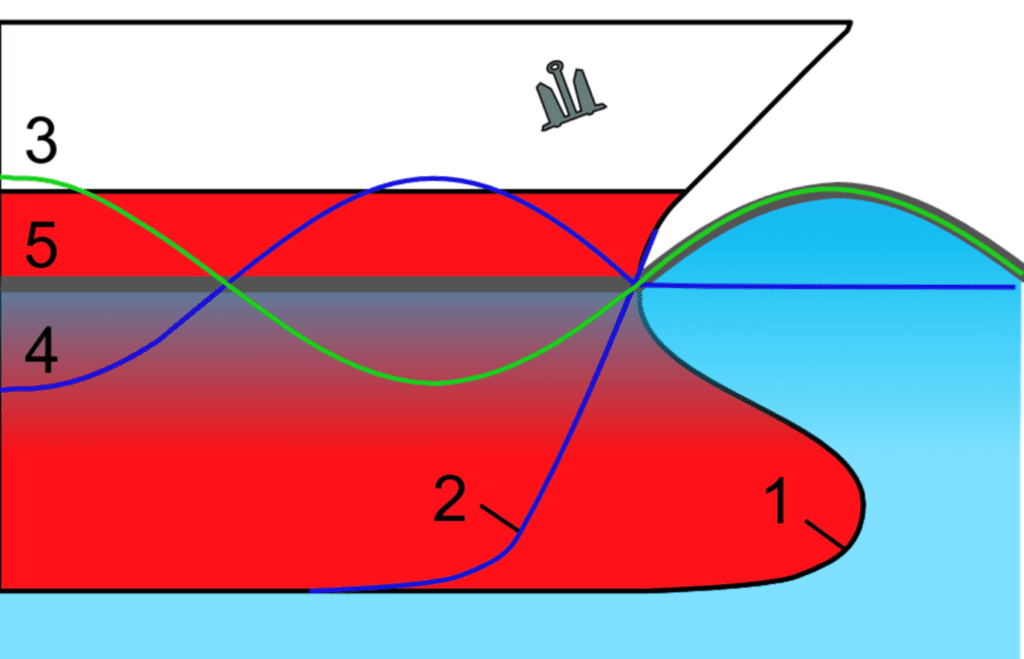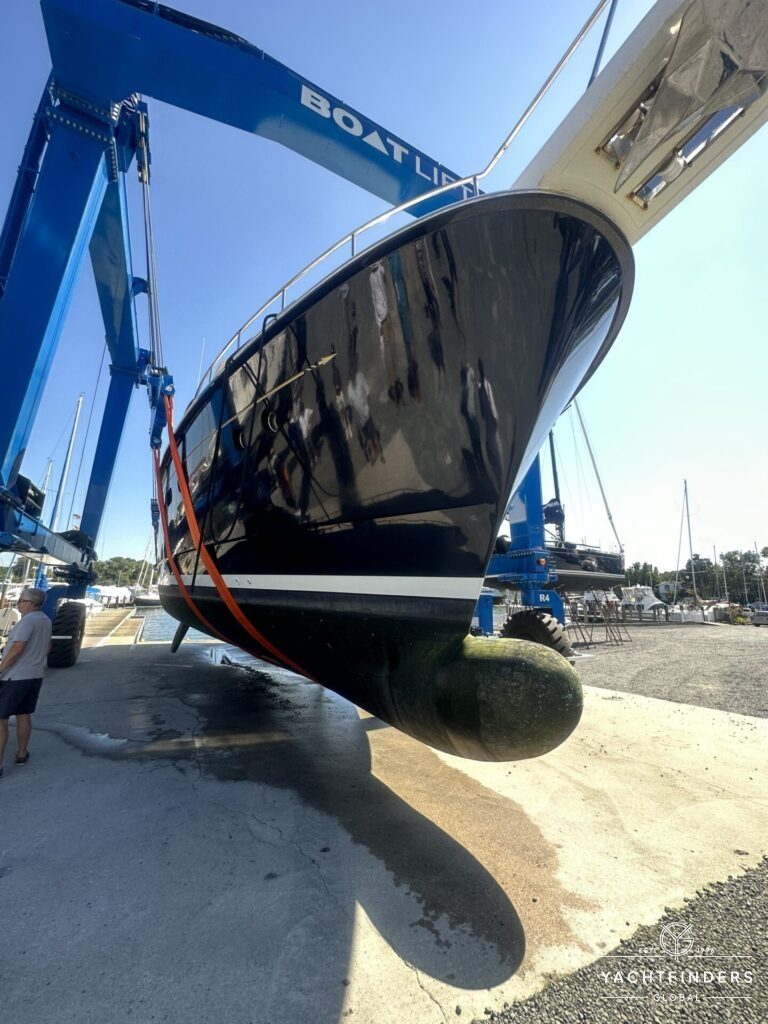An honest look at the lines of a Selene will cause one to think more of a “ship” than a “boat”. This is especially true with the larger models. There is no surprise here. A Selene is the same as a deep-sea ship when asked to cross vast oceans in comfort and safety.
Full-displacement hulls, large, slow-turning propellers, large rudders, and some means of stabilisation are all common elements that Selene and deep-sea commercial vessels share.
Bulbous bow
An additional design element almost always incorporated into the more prominent Selene is a bulbous bow. This is nearly ubiquitous on any commercial ship of decent size. You might see a simple line describing its benefits in a brochure or website. “The addition of a bulbous bow improves ride comfort and extends cruising range.”
Behind the scenes, however, much more can be said about how this little appendage delivers on its promise.
Interestingly, some of the first bow bulbs were created for a more offensive purpose. The Greek trireme, which had a bow bulb as a battering ram intended to disable enemy vessels. This was a decisive weapon in the Battle of Salamis against the Persians in 480 BC.
At 120 feet long and powered by 170 rowers, the trireme was built to be fast and manoeuvrable, capable of speeds of 7.5 knots under power and 14 knots under sail. And you can bet the underwater battering ram on the bow aided in the vessel’s performance.
Wartime vessels of the early 1900s began to incorporate a bulbous bow design specifically for speed. Soon after that, scientific studies were conducted to get into the dynamics of what was happening. By the 1930s, bow bulbs like what we’re used to seeing today began to find their way onto passenger ships and commercial vessels. They were mainly used for increased speed and then later for efficiency and fuel consumption improvements.
Greater fuel efficiency
Today, you would be hard-pressed to find a tanker, container/cargo ship or passenger ferry not taking advantage of the bulbous-bow design. It typically results in a reduction of power of at least 5% while running at speed and a substantial corresponding decrease in fuel consumption over the lifetime of a vessel.

The primary purpose of a bulbous bow is to create wave interference, ultimately allowing the ship to travel faster.
The primary purpose of the bow bulb is to reduce hydrodynamic drag and allow the boat (or ship) to move more quickly through the water. This is achieved by designing the bulb to create an additional wave that will partially cancel out the influence of the bow wave created by the hull (“wave cancellation” or “destructive interference” for the textbook crowd).
Less stern wave and less drag
In many cases, the bulb can also reduce a boat’s tendency to “squat” at the stern at higher speeds. Significant squatting can produce a sizeable stern wave, resulting in increased drag. In addition to minimising the tendency to squat, the bulb can also significantly reduce pitching (the rising and falling of the bow), which results in a much more comfortable ride.
Of course, all these bulbous bow benefits did not go unnoticed by passage maker builders like Selene – and not surprisingly, the trawler type of vessel turns out to be well suited to using a bow bulb. Our first experience with a bulbous bow was with the first N62 built in 1991.
Greater wave reduction
The boat was conceived and designed from the ground up using a cylindrical bow bulb in mind, and tank test results with the model were more than encouraging. While a designer will typically hope for a reduction in resistance of at most about 8-10% when using a bulbous bow, testing of the Selene 60 revealed a 15% wave reduction and a 20% pitch deceleration at 9 knots, which is correct at the sweet spot for that hull.
Moving forward, the Selene 62 and 66 were designed using the bulbous bow with results as good as or better than the Selene 60.
Remember the anchor …
However, the bow bulb is not without its detractors. The first and most obvious is anchor handling. A captain or owner who forgets about the bow bulb being down there while handling the anchor will likely be reminded of its presence in unforgettable terms.
In other cases, depending on overall hull shape and the many other factors that come into play, the bulb can cause what some might consider to be an unwelcome amount of noisy pounding or slapping while going to weather in rougher seas – especially with the smaller yachts. Bow bulbs are not fitted on Selene’s smaller models to make the ride as quiet as possible.
Even though a bow bulb would undoubtedly improve the lifetime fuel economy of the Selene 60, 62 and other smaller boats, it was decided that the benefits were not worth building a boat that some might find noisier than they’d like.
An option on larger Selene boats
Currently, the bulbous bow is offered as an option on all the larger Selenes, starting with the 60 (and it is standard on the new N120, where tank testing points to a wave reduction of at least 10%). Specific cruising habits and locations might influence a buyer’s decision to include a bulbous bow. Most of the larger boats end up leaving the factory with a bulb attached.
The advantages of a bulbous bow are evident and well-documented. However, we are just beginning to scratch the surface concerning how these appendages can be designed and used specifically for our kind of boat.
Naval architects are using computer modelling as a low-cost method to search out possible winning designs that can later be invested in for actual tank testing. Cross-sectional area, shape, length, and other factors can all be tweaked to produce different results to bring out a bulbous bow’s advantages while minimising its detractors.
And if you’re in a hurry, you can always take your current boat down the boatyard and have an aftermarket bow bulb fitted. This is not uncommon. Just remember that it’s down there before dropping anchor!

